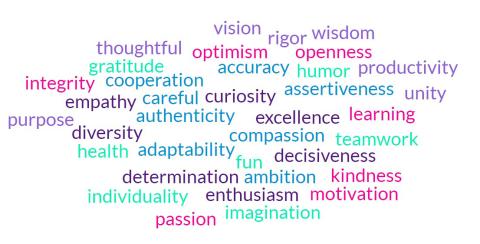What’s Your Pop-Tart?
Wooten Offers Tips for Everyday Leaders

Leadership is a critical skill that defies job title.
“Each of us are everyday leaders,” said Dr. Lynn Perry Wooten, president of Simmons University in Boston, at a recent NIH Deputy Director for Management (DDM) series seminar. Her virtual presentation contained four mini classes with lively discussions on communicating and collaborating in usual and unusual times.
Good communication, she said, starts with presenting your authentic, best self. Your identity, values and unique skills all are strategic assets in the workplace.
“What are you bringing into NIH that influences your communications strategy?” Wooten challenged. Identity encompasses many strategic nuggets—culture, upbringing, family, interests, personality, age and generation, and experience among them. Job title also is an asset.
“You show up with your role and you show up with your soul,” she said.

Your values offer another source of competitive advantage. What among many dozens of core values guide your work and can help empower your colleagues? Awareness, empathy, motivation, learning, fairness, diversity, resilience, to name a few. One of Wooten’s is the pursuit of excellence.
“I’m that mom if you get a 99 on the test, I’m going to ask you about that one point,” she said. “In my communications strategy, I’m always talking about excellence. What are the results we want to produce? What does excellence look like? How can I support you in excellence?”
Bringing your authentic self to the table engenders trust and strengthens relationships, Wooten said, drawing on advice from Carla Harris, senior advisor at Morgan Stanley and a past DDM speaker.
Another powerful way to lead with impact is storytelling.
“Stories define who we are, give us a purpose and show where we’re going,” Wooten said in her second mini class. At work, stories help colleagues connect, share values and have difficult conversations. Stories can grab attention. They can be memorable and persuasive.
“Our brains are wired for stories,” she said. “They make us visualize something; they personalize it. Every story becomes relational and a call to action.”

In telling stories at work—perhaps about an opportunity or an inspirational person or overcoming an obstacle or highlighting a personal value—make the characters vivid, she said. Set the scene. Have a goal in mind. Define the desired outcome or lessons learned. Use data where appropriate. Make your story a teachable moment.
A third mini class addressed a topic many people dread—meetings. Wooten has a different take.
“Meetings are where things happen in organizations,” she said. “Meetings are where work is planned, where work is done, where we build community. It’s where we have learning.”
Whether in-person, virtual or hybrid, meetings boost engagement and keep staff in the loop. They’re a place to showcase stories, persuade and inspire.
“Everyday leaders,” she said, take note. “If you want to be effective at communication, you need to know how to show up and engage in meetings and how to plan them.”
Be intentional, Wooten advised. Go in with a vision and a path to action. Use that time to build relationships and foster teamwork and trust.
“Everything you say in a meeting should advance the individual and team learning,” she said. Reverse the bad reputation of meetings. “People should look forward to meetings for personal reasons and professional development.”

Leaders also must adapt communication during unusual times. Crises are inevitable, yet there are strategies to help navigate them. In the fourth mini class, Wooten tied in her earlier tips and tools, showing how meetings, storytelling and being authentic are all integral during times of crisis.
“When crisis hits, communications and actions must change,” Wooten said. “We have those meetings, but we’re uncertain. Decision-making happens under pressure. The team must come together to be agile, creative and seize opportunities.” It’s a time for collective action while leaders are managing and adapting for resiliency and learning.
Wooten outlined five crisis phases. The first is scanning the environment, gathering data and perspectives, making sense of the emerging situation. Then, there’s the preparation and prevention phase—debating and employing creative practices and solutions. Next comes containment, a period that may require risk-taking and certainly requires communicating to allay fears among teams and across the organization. During the last two phases, business recovery and learning in action, leaders bounce back and plan ways to improve.
“Even in a crisis situation, you can have innovation,” she said. “You can boost employee morale. You can make sure stakeholders feel supported.”
During the pandemic, storytelling was a successful strategy to motivate people to get vaccinated, Wooten noted. And purchasing data in crisis times helped a major chain keep up with demand. Data showed people not only stocked up on water and batteries, but they also bought a lot of Pop-Tarts—a quick, ready treat that appeased their kids.
“What is your Pop-Tart in the organization?” Wooten asked. “How are you preparing? In a crisis, it’s ‘all hands on deck.’ There’s no expert in the room. You’re like a jazz band—everybody is improvising.” What will you learn and how will you bounce back?
“Crises are opportunities to communicate and be creative and really think about how we can build a better world.”
For more, see: tools for communicating in times of crisis
